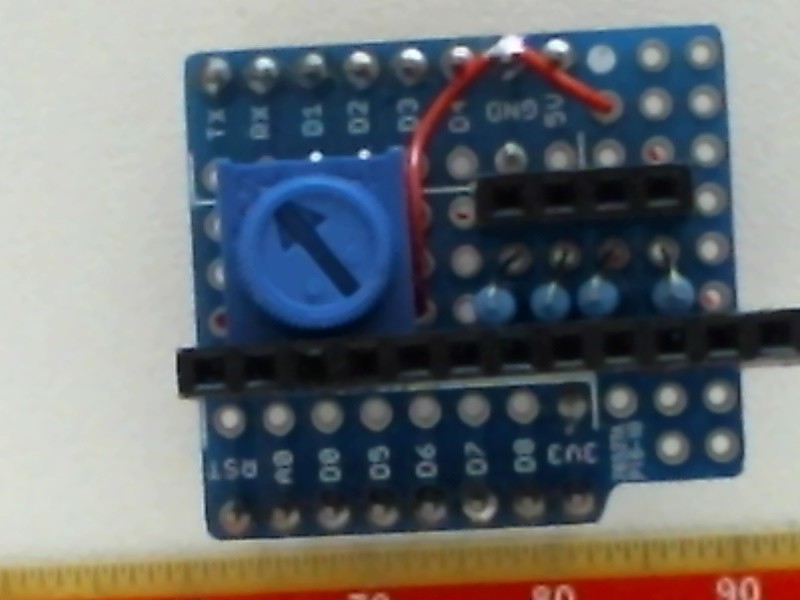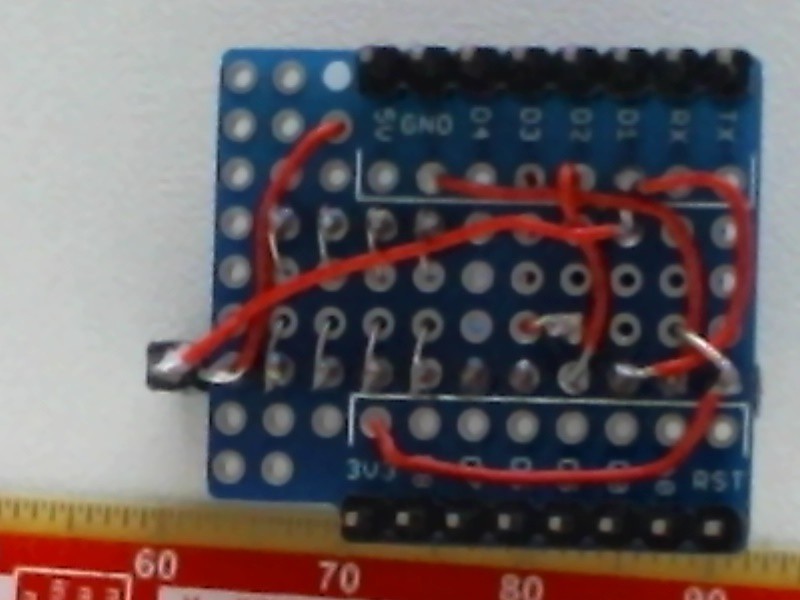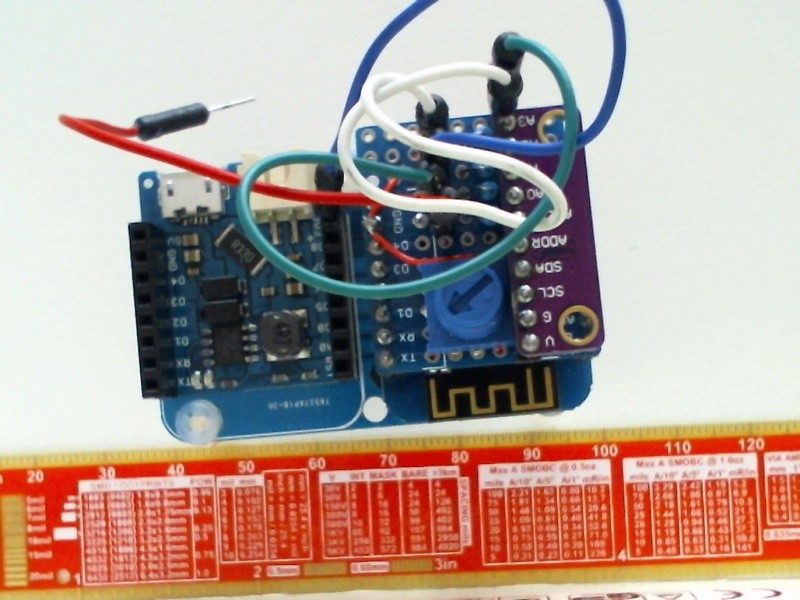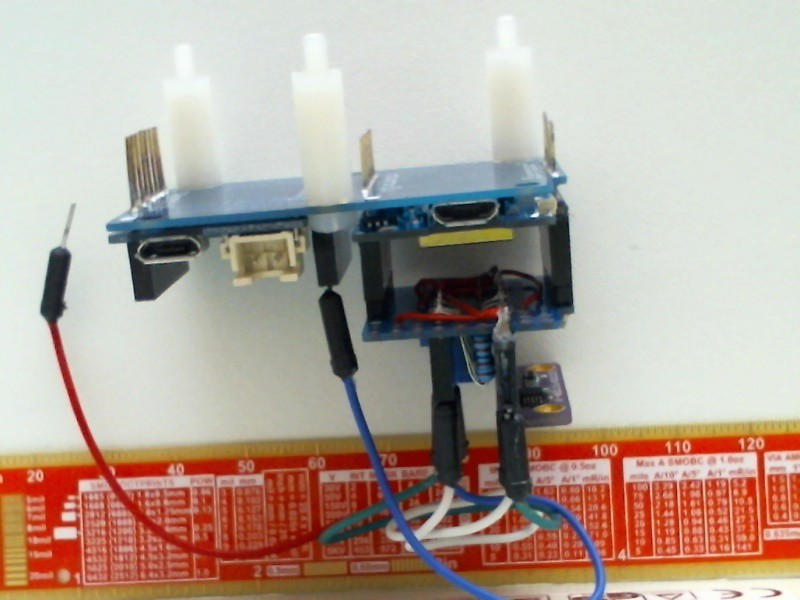-
Active learning of circuit protection
05/29/2017 at 19:33 • 0 commentsWhen one needs to change a connector for a rechargeable battery, he/she will connect the red wire from the battery to the red wire of the connector, right?
The same goes to the black wire, right?
I was sure too until I learned this could be wrong by means of active learning.
I must admit I have never used Li-ion polymer (LiPo) batteries before because 5V powerbanks were good enough for my portable projects. This time the size of a bank and the need for a cable called for using a bare battery instead. I happened to have two batteries shown with a LiPo charger below
![]()
that came a while ago (before some overdensied batteries started catching fire) as parts of some kits. Sparkfun and Adafruit websites provided all the information I required about these. The battery on the left does not feature built in overdischarge protection circuitry but can source substancial currrent (25C on the label means up to 25*720mA). It is commonly used for radio controlled (RC) models where the user is reponsible to switch the battery off on time when its voltage drops close to 3V. The battery on the right is equiiped with this protection, which adds expense but allows for unattended operation. Unfortunately both batteries and the charger came with JST (name of the company developed self-locking connectors withstanding vibration well) connectors of different spacing (shown below with mating connectors, respectively 2.0, 2.54 and 1.0 mm connectors from left to right)
![]()
Interestingly, both batteries not only came charged but also retained quite a bit of charge after being stored for a few years. This was discovered without using any instruments. When I cut off the bigger connector in one go I shorted the battery with the cutter and wires started burning straight on (not very surprising for a rated 15 A max current). As it happened, even after this short the battery retained over 4 V on its terminals. The other connector was cut off one wire at a time then.
When I started soldering battery wires to the 2.54 connector, I recalled a recently viewed video regarding a story which started when rechargeable batteries were connected to a power supply in a wrong way. Of course this would not happen to me as I connected red (positive terminal) to red and black (ground terminal) to black. For this reason I just plugged the battery into the shield. More smoke followed, now from the battery shield. After disconnecting things I found that color marking of wires on the batteries I had and 2.54 connectors was exactly opposite to each other. The battery still retained over 4V thus was ready for even more damage. (I recall a university friend whose project eventually turned into what he finally named 'a device for destroying transistors' despite this was not the original purpose. No doubts this LiPo battery could be used to power the device without the mains adapter making it possible destroying transistors anywhere in the field.)
This way of learning things is called active learning - since I even make sure that the wires are not covered with the heat shrink tube not to forget to check the polarity before connecting the batteries to any new board
![]()
Inspection of the battery shield showed that the TP4056 integrated LiPo charger reacted to the abuse by releasing its magic smoke (note 1)
![]()
Some people say that a fool learns from his own mistakes and a wise man learns from mistakes of the others. As only wise people read this log, I will refer to and discuss some protection options:
- electroBOOM video (protection of a power supply from attaching batteries with reverse polarity using a single diode);
- EEVblog video (detailed analysis of input protecting circuitry for digital multimeters using metal oxide varistors (MOV) and quick blow fuses);
- the purpose of the series resistors for the ADC module. As it happens, most if not all integrated circuits have two diodes internally connected to every input pin to protect it from electrostatic discharge. This used to be a very common cause for destroying semiconductor components; here there is a schematic diagram and discussion for this sort of protection. Adding a resistor in series makes hese diodes working as a voltage clamp. The datasheet of the ADC chip from the ADC module states that these diodes can withstand 10 mA of continuous current. With the series resistance of 10 kOhm one would expect the module not to be damaged even if the resistor is connnected to say, a 50 V source with decent safety margin. Without this resistance such a connection would increase the amount of magic smoke in the wild.
The module will be unable to measure any voltage beyond the one of its power supply but this can easily be fixed with a potential divider.
The downside of using the series resistor is that it makes some potential divider with the input impedance of the pin as well, understating the measured voltage compared to the actual value. As the input resistance of the ADC channels exceeds 3 MOhms according to its datasheet, this understatement will be around 0.3% which seems acceptable to my needs. If the need for more accurate measurement arises later, each channel of the voltmeter should be compared against known (or measured with high accuracy and resolution) voltage. The actual to measured voltage ratio can be used to multiply the measured values later.
Finally, I have a few TP4056-based boards on order and hope that I will be able to replace the burnt one on the Wemos mini shield mitigating damage caused by active learning this time.
Note 1 - any electronic component operate because it contains some quantity of magic smoke. When the smoke goes out, the component cannot work any longer.
-
Hardware - revision 1
05/27/2017 at 18:15 • 0 commentsThe first revision of the IuT voltmeter was built using the Wemos mini prototyping system, in particular D1 mini board and matching shields: dual base, battery shield, protoboard shield.
(Note 1: more about Wemos D1 mini shields - at the end of the log entry)
Dual base and protoboard shields are shown in the picture below with a ruler for scale:
![]() The battery shield is on the left, the header with protruding pins to stack the boards in the centre, and the D1 mini board on the right.
The battery shield is on the left, the header with protruding pins to stack the boards in the centre, and the D1 mini board on the right.![]() Some care is required when soldering the stakable headers to keep them aligned. I used a spare male pin header as shown below:
Some care is required when soldering the stakable headers to keep them aligned. I used a spare male pin header as shown below:![]()
Every Wemos board has a cut out. In order not to short shields one should use the same direction for the headers on all the boards. I placed the cut out as shown above in order to have the soldered SMD components between the female pins.
I always use extra flux for soldering (Note 2: why use some extra flux and what are the options). Flux left some residue
![]() which was removed later:
which was removed later:![]()
I wanted to save some space with this prototype and have flexibility to adding more shields. For this reason I soldered the D1 mini board and battery shield to the base directly (rather than using extra female headers on the base) and used spacers to support the base. Here is the view from the bottom
![]()
and one from the above
![]()
The protoboard shield was used to attach a female header for a standard ADS1115 (or ADS1015) ADC module (Note 3 : the differences between ADS1115 and ADS1015 ADC modules). I mounted D1 mini common header pins (both sides of the protoboard), a female measurement socket for connecting male-to-male wires to the breadboard (left of the centre); female socket for the ADC module (right of the centre), four resistors connected in series between the module's inputs and the measurement socket for input protection discussed later (leads visible between the female sockets),
![]()
and connected interface pins of the ADC module to the D1 mini pins.
The module uses I2C nterface which requires connecting respective SDA and SCL lines of the D1 mini and module together (no note here as there are plenty of resources on the net, I only briefly menton a few essential things). The module integrates compulsory pull up resisotrs for both the lines (10k each). Wemos I2C shields use pin D1 as SCL and D2 as SDA; this convention was followed here.
By onnecting the ADR pin differently, the user can select one out of four available I2C addresses. I connected the ADDR pin to GND selecting address 0x48.
As the board still had some unoccupied space, I added a potentiometer (pot) to enable the board's self-contained testing by connecting an ADC channel to the pot's wiper. The oher terminals of the pot were wired to the ADC module's power supply rails.
The complete connections diagramm is shown below
![]()
That is how the shield with the ADC module looks from the top
![]() The same shield with the ADC module removed shown from the top
The same shield with the ADC module removed shown from the top![]()
and from the bottom
![]()
When the assembly was first plugged into a PC USB port, the LED on the D1 mini board momentarily blinked indicating correct operation. At this stage I considered construction of the revision 1 completed. The photographs below show how the final assembly looks like with the jumper wires connected to various pins (3.3 V, ground, potentiometer) for testing purposes.
![]()
![]()
Note 1: more about Wemos D1 mini shieldsOriginaly D1 mini modules and shields were supposed to be connected like Arduino Uno and its stackable shields. However some of the shields are too tall (e.g., relay shield) and need to be placed on the top of the stack to be useful (e.g., button and OLED shields). Dual base shield addressed this shortcoming, and 'tripler base' shield was introduced recently.
Dave Jones from EEVblog recently used a Wemos mini module and discussed his experience of programming it with the Arduino IDE.
Note 2: why using some extra flux and what are the options
Soldering uses molten solder to first wet metal pieces then to hold these together when the solder solidifies. The surface of these metal pieces is commonly covered with oxides and other substances/films that prevent the solder from wetting them properly. Flux dissolves these contaminants then evaporates with visible smoke.
(In the past people used to inhale these smokes and it did not make huge impact on their life expectancy because they suffered much more from oter things. However if you want to claim your pension for some time after getting retired, get a proper fume extractor or at least have some fan to blow the fumes away from you.)
Most people use either 'no clean' or 'water soluble' flux that do what their names say.
'Water soluble' flux is preferable if you want to demonstrate your board for some academic or social credit; it is used in industry for some consumer products. To remove the flux residue, use warm water with some soap/detergent/washing up liquid and lint-free brush. Watch out for
1) removing the residue quickly enough; if left for substantial time (say, a few days), this flux might corrode the board and components;
2) there are components that do not like to be bathed like speakers, microphones, exposed sensors, buzzers (most have a sticker that needs to be removed after cleaning the board) etc.'No clean' flux residues do not affect most circuits. (Removing these residues is still possible by using idustrial lint free wipes with more agressive solutions which cost money and require some care to use.) This is generally a more convenient option when one does not care about the board's appearance.
Note 3 : the differences between ADS1115 and ADS1015 ADC modules
Appearance - the same
Schematic - the same
Connections - the same
Number of independent single-eneded input channels - 4 for both
ADC resolution (how many bits are in each ADC reading) - 16 for ADS1115 and 12 for ADS1015 (higher resolution is better for all the other things equal)
Maximal sampling rate (how many samples per second - SPS - the ADC can produce) - 860 for ADS1115 and 3300 SPS for ADS1015 (faster sampling is better for all the other things equal)
Cost - ADS1115 is a tad more expensive
Command set and internal register structure - fully identical (thus the same firmware driver can be used to operate any of the modules)
Format of the returned data - both return 16 bits; 4 least significant bits of ADS1015 are always zero (thus the same code can be used to process the returned samples)
The sad truth is that I bought ADS1115 module but its resolution will most likely not be fully utilised. If I manage to get fast communication between the client and ESP server, the higher sampling rate may become an advantage for alarms, graphing and logging measured volatges. Hopefully I will be able to revisit these considerations later.
IuT voltmeter for a breadboard
Measure several voltages on a breadboard and display results on a smartphone for less than $10 for parts
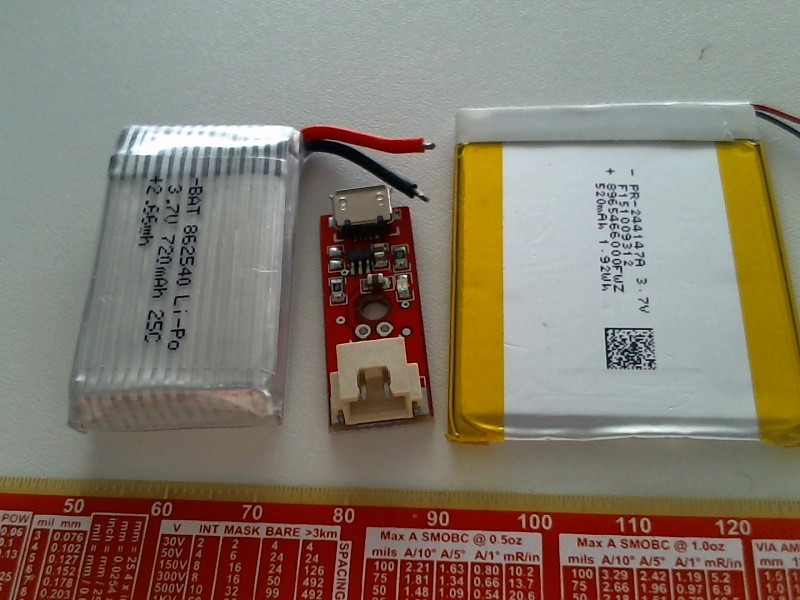
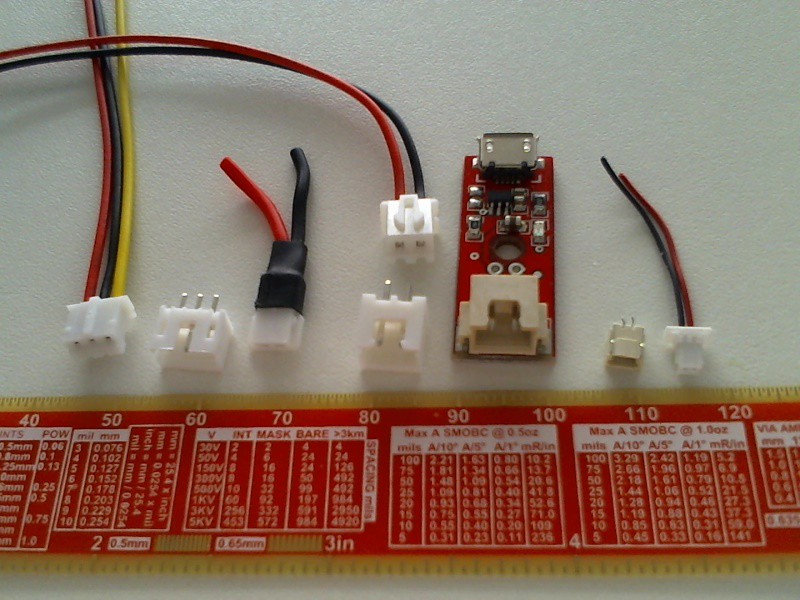
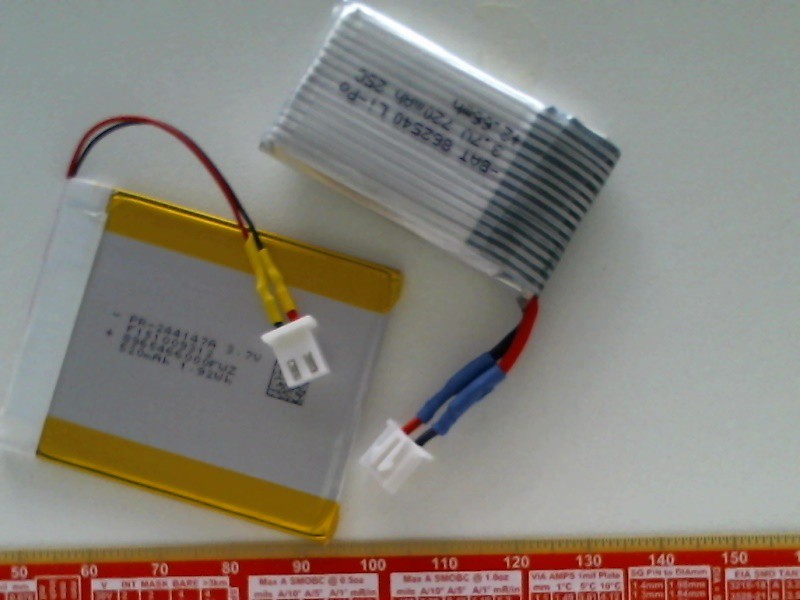

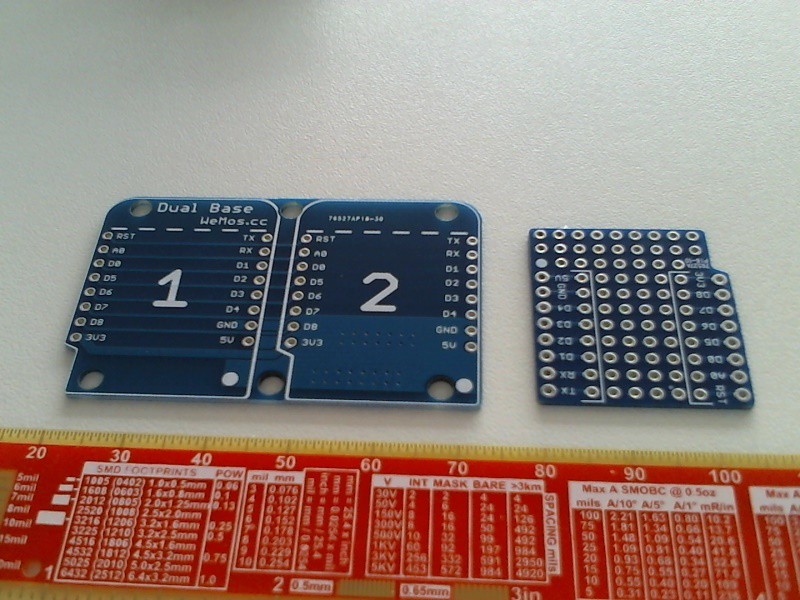 The battery shield is on the left, the header with protruding pins to stack the boards in the centre, and the D1 mini board on the right.
The battery shield is on the left, the header with protruding pins to stack the boards in the centre, and the D1 mini board on the right.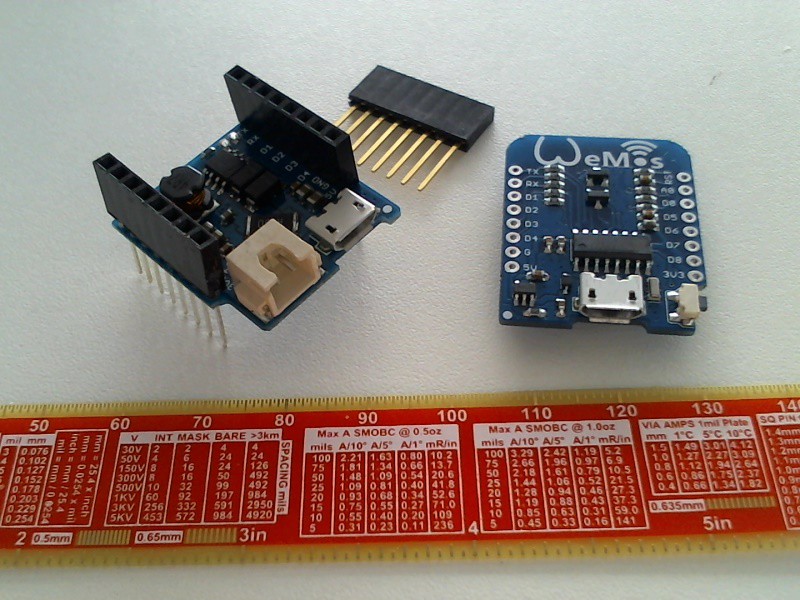
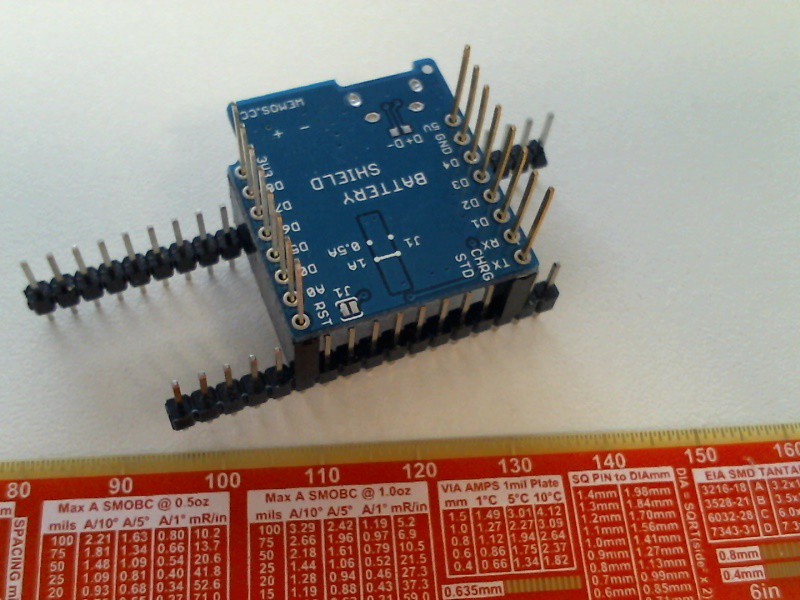
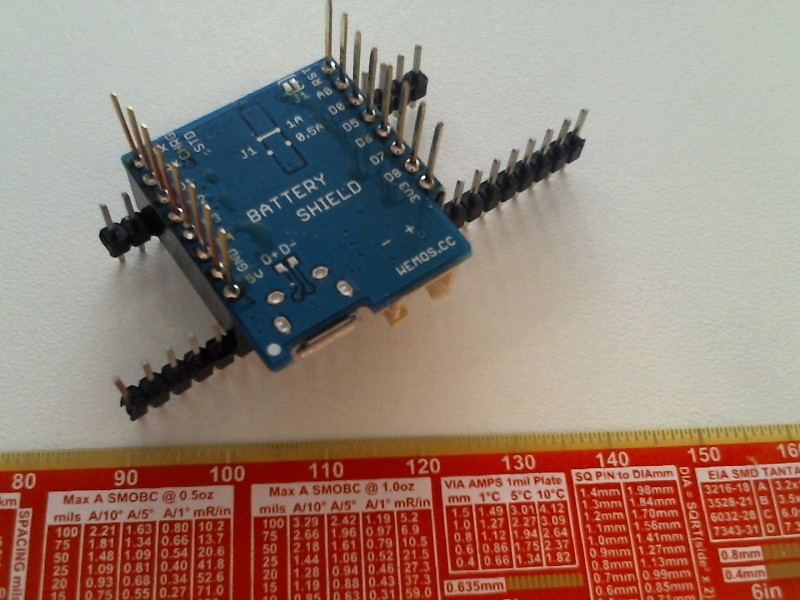 which was removed later:
which was removed later: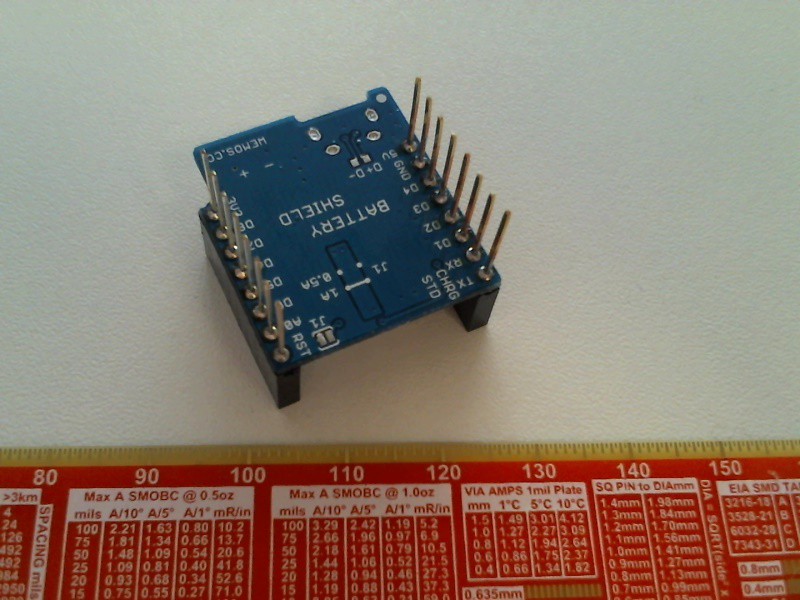
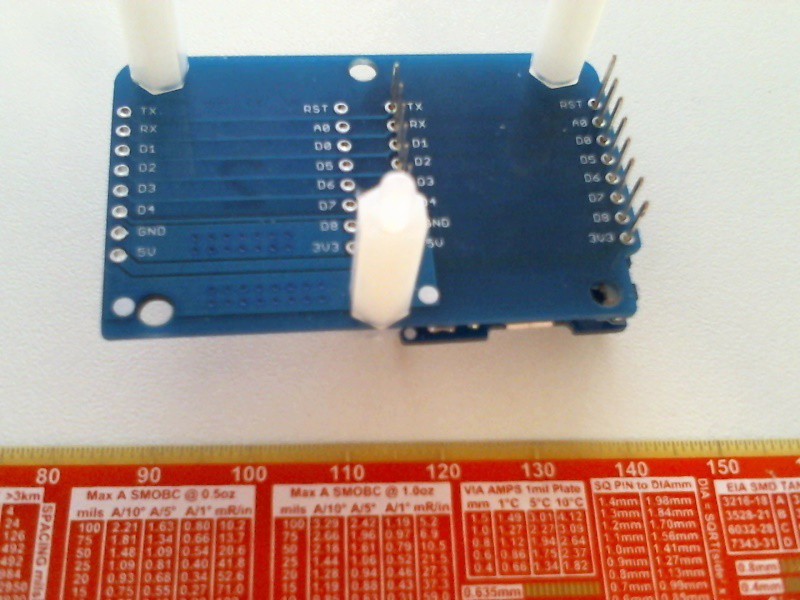
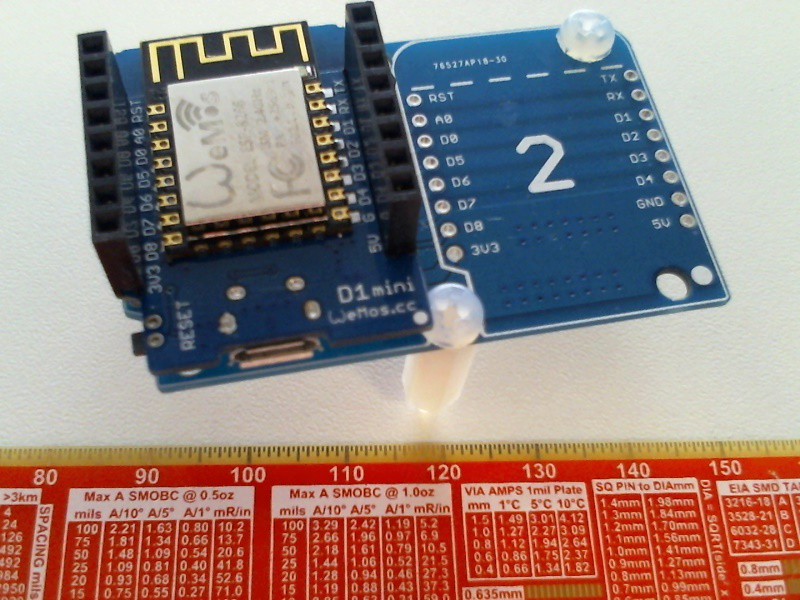
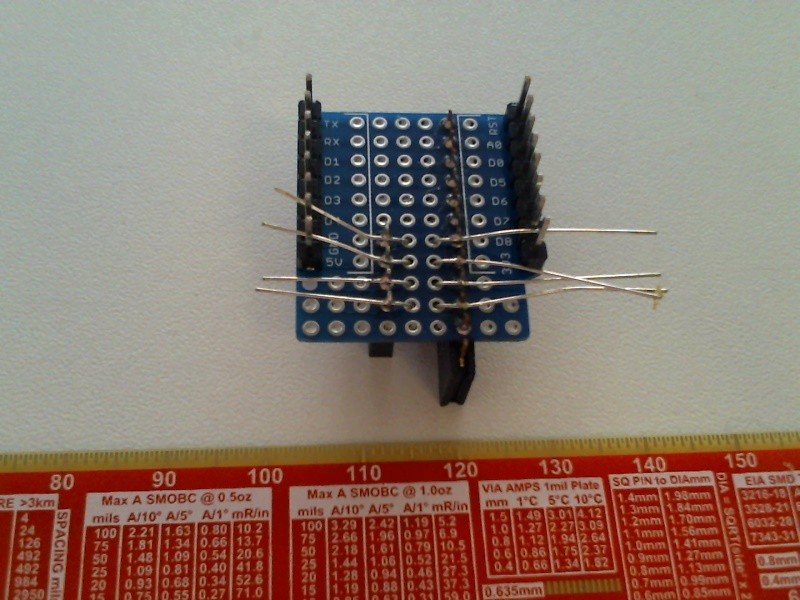

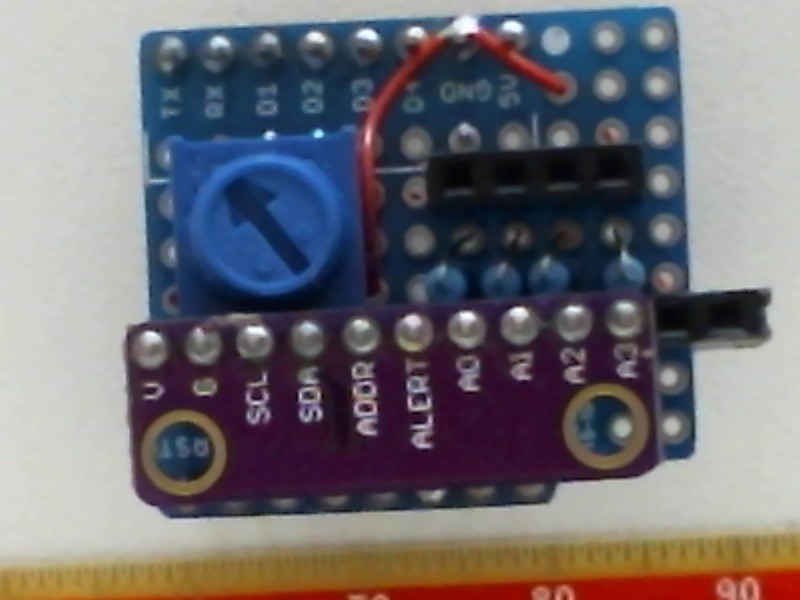 The same shield with the ADC module removed shown from the top
The same shield with the ADC module removed shown from the top